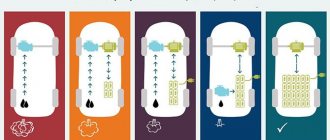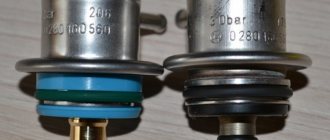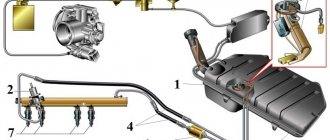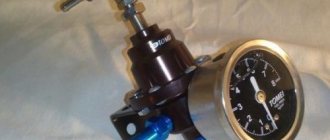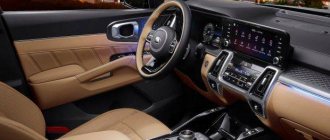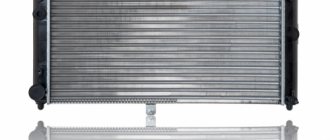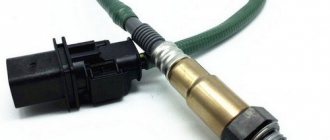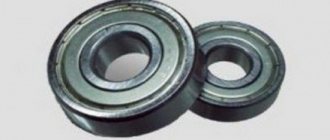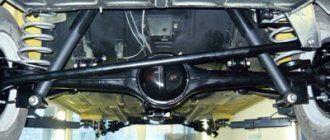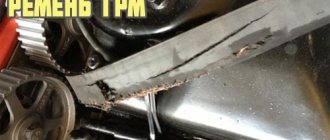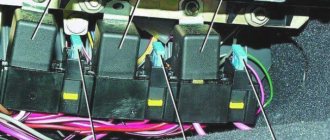On VAZ-2110 vehicles, the fuel pressure regulator ensures the functioning of the fuel injection system in normal mode. With its help, the optimal pressure value necessary for the gasoline to be in a state of fog is maintained in the fuel rail. Due to the pressure, which is higher than atmospheric, the air-fuel mixture is injected into the combustion chambers. If the regulator fails, the entire injection system does not work correctly and serious problems in the functioning of the engine are possible.
How regulators work
The fuel rail is necessary to mix gasoline vapors and clean air. It maintains pressure at 2.9-3.3 kgf/sq. cm due to the pressure regulator. For injection, injectors with a solenoid valve are used. A regulator is connected to them, which is a valve made of a membrane. The device inlet is from the ramp side, the outlet is on the fuel drain line. A tube from the intake manifold is connected to the VAZ-2110 fuel pressure regulator.
The pressure is adjusted using a spring; its rigidity is selected so that it compresses only with a certain force. If the pressure of the fuel mixture in the rail exceeds 3.3 kgf/sq. cm, then the spring compresses, the valve opens and the excess is released into the return line. When the pressure reaches 2.9 kgf/sq. see the valve closes.
The principle of operation of the main elements of the fuel unit
Video Replacing the cabin air filter on a VAZ 2114 VAZ 2115 VAZ 2113 Lada Samara 2
Fuel system VAZ 2114
Container for storing flammable materials
It is made of steel, consists of two firmly welded parts, the neck through which the fuel enters is connected to the tank with a rubber pipe and secured with clamps.
Gasoline pump
This tool with an electric mechanism is located in a tank with a fuel mixture level indicator. Its actions are coordinated by the engine control box, through a special pump relay, which supplies fuel through the line to the injectors. At idle or when the engine is completely turned off, the pressure is maintained due to the action of a one-way lock, which is located near the unit itself.
The VAZ 2114 power system has a fuel pressure regulator and injectors. The voltage is supplied to them from the battery through the main relay. Thus, the amount of driving fluid is indicated by the duration of the pulses, which are generated by the engine control unit and transmitted to the injectors.
Ramp
Located on the intake manifold, it includes a fuel control element and a pressure valve with a spring-loaded diaphragm. It, in turn, divides the regulator body into 2 parts: the fuel part regulates the pressure of the combustible mixture, the air part, due to the rarefaction of the air, raises the membrane and produces constant fuel pressure readings in the rail.
When the engine starts, the vacuum behind the damper decreases, the diaphragm closes the power system valve, so the pressure increases. When the vacuum is maximum, then the fuel pressure decreases. The regulator is not dismountable, so if it fails, it is replaced with another one.
Fuel mixture control sensor
The pump module has a float, which is located in the tank cavity. When the position of the float changes, the resistance of the unit changes proportionally. According to a certain signal, the fuel quantity indicator on the dashboard displays the presence of fuel in the system.
Why does the sensor often fail?
- fragility of the case;
- frequent temperature changes;
- condensation formation in the tank;
- when using a low-quality combustible mixture;
- oxidation of contacts when sealing is broken.
That is why it is so important to carry out preventive maintenance on time, clean the unit, change contacts in order to prevent its destruction. Changing a device is not that easy. Many markings are original and unique, which means that the services of professionals will be required, which are also not cheap
Many markings are original and unique, which means that the services of professionals will be required, which are also not cheap.
Hoses and pipelines
Such irreplaceable products guarantee uninterrupted circulation of flammable liquid from the container to the main line and nozzles, and if there is excess, they transfer the residual liquid back to the tank. The pipelines are located on the bottom of the vehicle, they need to be carefully checked, cleaned, inspected for integrity, various deformations identified and promptly eliminated in order to avoid fuel leakage, as well as poor transmission to the injectors.
Another function of the pipelines is the transfer of fuel vapor from the tank to the activated carbon section, where waste is collected when the engine is turned off. After it is started, the electromagnetic device is triggered and the vapors escape into the engine, where they are destroyed.
Highway
The design of the VAZ 2114 fuel system includes a main line that guarantees the supply of fuel to all injectors. Today, the fuel pressure regulator is placed in the tank and is not located on the line; there is also a service valve, which performs the function of eliminating air after a technical inspection of the vehicle.
The fuel injection system of the VAZ 2114 includes an uninterrupted mode for collecting fuel vapors, and the gravitational unit located in the device helps prevent fuel from leaking when the vehicle is in an emergency position.
When the engine's air consumption is high, the system is purged more intensively. The filter element is made of durable paper material, after which the air moves through the mass air flow sensor and moves into the intake hose, which leads to the throttle assembly.
Thus, the operation of the fuel fluid supply mode of an engine with a fuel injection system on a VAZ 2114 car occurs.
Types of faults
Among the most common device breakdowns are the following:
- The valve does not hold pressure - gasoline circulates freely throughout the entire line, including the return line. In this case, the pressure in the ramp decreases significantly, and it may not be constant. When you increase the engine speed, it begins to stall - there is not enough pressure to carry out normal injection. The amount of gasoline inside the ramp is very small. There is a noticeable decrease in power; it takes longer to start the engine than during normal operation. The electric fuel pump will run longer than usual.
- The valve does not work at all (does not open at maximum pressure) - the excess does not go into the tank. The pressure in the fuel rail is too high, significant excess consumption of gasoline occurs, and the cylinders are flooded. This malfunction of the fuel pressure regulator on the VAZ-2110 cannot be eliminated, so you only need to change the device completely.
Reference
Many people know that the fuel system valve aggregates:
- With carburetor power units running on gasoline.
- With engines equipped with an injector.
- With power supply systems for power plants, where diesel fuel is used as fuel.
There is nothing complicated about the mechanical design. This is a ball-type device with a seat, which is made of soft metal, with the most accurate balancing. Fuel flows freely through the fuel valve in one direction. The pressure that is created prevents gasoline or diesel fuel from flowing back into the fuel tank, since the non-demountable structure is locked.
Despite its simplicity, the device can cause a lot of trouble for a novice and an experienced driver. Therefore, it is necessary to know its possible vagaries and ways to eliminate breakdowns. But first of all, understand where the mechanical structure is installed.
Signs of breakdown
To independently identify a breakdown of the device, take a closer look at the operation of the engine. Typically the fault appears like this:
- The engine's operation is unstable, it shakes, and misfires are felt in the cylinders.
- When idling, the engine stalls.
- Acceleration is weak - throttle response is low, driving is difficult.
- There is a noticeable decrease in engine power; even at minimum load it feels “heavy”.
- The crankshaft rotates either at a low or high frequency. Sometimes the rotation speed varies over a wide range.
- Significant increase in gasoline consumption.
- Jerks and dips during uniform movement.
- Sometimes the breakdown manifests itself as difficulty starting the engine.
- Among the signs of a malfunction of the fuel pressure regulator on the VAZ-2110, one can highlight a significant excess of CH and CO content in the exhaust.
The last breakdown is detected only when diagnosing the engine using a gas analyzer.
How can you check a check valve?
You can find out what condition the fuel valve is in as follows.
Using a pressure gauge, check the pressure. It should be within 3 kg per cm 2. These are figures for passenger cars.
You can find out how the device works by pinching the “return” fuel hoses. If the permanent mechanical structure is in order, the pressure should increase.
This method is only for cars that have rubber hoses installed.
Self-diagnosis can be carried out without using a pressure gauge. This concerns the problem of unstable operation of the internal combustion engine (ICE) and poor acceleration. Having pinched the rubber hose that moves the fuel in the opposite direction, you need to pay attention to the operation of the engine. If the speed increases and the engine cylinders operate as planned, then the check valve is faulty.
Regulator diagnostics
To carry out diagnostics you will need the following tool:
- pressure gauge (the one used to check tire pressure is suitable);
- open-end wrench 24;
- hexagons (only #5 is required).
And now about how to check the fuel pressure regulator on a VAZ-2110:
- Remove the plug from the fitting located at the end of the fuel rail.
- The spool can be unscrewed from the fitting using a cap (metal) for the wheel tires.
- Using a hose of suitable diameter, connect the pressure gauge to this fitting. Be sure to secure the edges with clamps - there is high pressure inside and it can break.
- Start the engine and measure the pressure.
- Disconnect the vacuum tube from the regulator and repeat the measurement.
When the vacuum tube is disconnected, the pressure should increase by 0.2-0.7 kgf/sq. see. If this does not happen, a complete replacement of the device is required.
Operating principle of the part
An RTD is necessary to maintain the difference in pressure on the membrane from 2 sides, that is, from two chambers. Without this, the motor will not be able to operate normally.
The sensor monitors the pressure, despite the current speed of the power unit. Fuel will stop injecting if the pressure in the manifold is the same as in the injectors or exceeds it. In order for fuel to flow, the pressure in the injectors must be higher.
If everything is functioning correctly, the diaphragm valve will open and admit the required amount of fuel, and as soon as the pressure in the injectors decreases, it will immediately close.
How to replace the regulator?
To replace the regulator, you will need to do the following:
- Stop the engine. Do not perform any actions while the engine is running.
- Relieve pressure in the rail. Simply unscrew the spool valve from the fitting and wait until the pressure equalizes.
- Unscrew the nut that secures the return line pipe to the fuel pressure regulator on the VAZ-2110.
- Unscrew the bolts securing the device body to the fuel rail.
- Remove the regulator fitting from the hole.
- Disconnect the tube from the body.
- Remove the regulator completely.
All steps to install a new device occur in reverse order. Be sure to soak all rubber O-rings in gasoline before installation. All rubber elements that are damaged or have lost their original appearance must be replaced with new ones. Poor quality gaskets and seals will lead to the entire fuel supply system not working properly.
Causes of fuel pressure regulator malfunctions
RDT may fail for several reasons. For example, defective parts are found on Russian-made cars. There are significantly fewer defects on foreign models, but you can purchase a defective RTD by purchasing a non-original spare part.
Mostly the check valve breaks down due to natural aging. Let's say this can happen after a hundred thousand mileage or more. It should be noted that check valve failures are not common. Most often, in an RTD, the membrane dries out over time, less often the valve jams, and even less often the spring breaks or weakens.
Sensor failure may occur due to low-quality gasoline. For example, in winter, fuel was filled with water, and water got into the regulator. If the fuel filter is not replaced on time, dirt gets into the parts of the power system, including the regulator. In this case, the RTD valve most often jams. It’s hard to imagine what could happen to the spring, but apparently, it still breaks sometimes.
Fuel system diagram for VAZ-2112 injector 16 valves: photo
The fuel system is one of the most important components in any car. After all, without it it is simply impossible to imagine the full operation of the vehicle. And so that you can imagine what the fuel system on your VAZ-2112 consists of, below we will present you with its detailed diagram, with a detailed description of each of the main elements.
Detailed diagram of the fuel system
Detailed diagram of the fuel system.
1 — nozzles; 2 — fitting plug for monitoring fuel pressure; 3 — injector ramp; 4 — bracket for fastening fuel pipes; 5 — fuel pressure regulator; 6 — adsorber with solenoid valve; 7 — hose for suction of gasoline vapors from the adsorber; 8 — throttle assembly; 9 - two-way valve; 10 - gravity valve; 11 - safety valve; 12 - separator; 13 — separator hose; 14 — fuel tank plug; 15 - filling pipe; 16 — filling pipe hose; 17 — fuel filter; 18 — fuel tank; 19 — electric fuel pump; 20 — fuel drain line; 21 - fuel supply line.
Below we will look at the main elements of the fuel system separately.
Fuel tank
Dismantled VAZ-2112 gas tank.
The filled gasoline is supplied from the tank, which is located in the rear of the car, in the area where the sofa is located. The tank is made of steel and assembled by welding two stamped parts. Gasoline is supplied to the tank through a special neck, from a gas-resistant hose made of rubber, secured together with clamps.
Gasoline pump
Fuel pump VAZ-2112 1139009
A gas pump is an electrical functional device, submersible, installed directly into the gas tank itself. This pump is started by a signal from the ECU controller, which is responsible for fuel injection, through a relay when the ignition is turned on. If the fuel pump doesn't pump, the engine won't start! The operating pressure of the pump is at least 2.8-3 bar (atmospheres - approx.). In order to get to it, just lift the rear sofa and unscrew the technical hatch.
Fine filter
The new filter is ready for installation.
From the fuel pump, through a flexible steel hose, gasoline passes under pressure to the fine filter. The filter is made of steel and cannot be disassembled. A special paper filter element is installed inside. On the housing cover there is a special arrow, created for visual indication during installation, showing the direction of movement of gasoline in the system.
About replacing the fuel filter in this material.
Fuel rail
Through steel fuel pipes, after filtration, gasoline passes directly to the fuel rail. It is designed to transfer gasoline to atomization and is mounted on the “outlet”. On one side of the fuel rail there is an RTD, on the other there is a fitting for controlling gasoline pressure. The pressure in the ramp in operating condition should be from 2.8 to 3.2 bar (2.8-3.2 atmospheres - approx.) - this indicator depends on the stabilization in the receiver, indicating constant differences in them. This is necessary in order to dose the optimal amount of gasoline into the injectors.
Fuel pressure control
Be careful when dismantling.
An RTD is a special device with a valve, assembled with a special diaphragm with a spring retainer. Under the influence of this element, the working position is in the locked type. It is also designed to divide the internal space of the regulator itself into two closed cavities - air and fuel.
The cavity for air is connected to the hose and receiver, and for fuel it is connected to the structure itself on the ramp.
During operation of the motor, the vacuum overcomes the resistance created by the spring and tries to tighten the diaphragm, thereby opening the valve. And from another position, at this time, gasoline presses on the diaphragm, also influencing the spring. As a result of this action, the valve opens slightly and part of the fuel flows back into the gas tank through the fuel line.
When the gas is pressed, the vacuum behind the throttle valve (throttle valve - approx.) becomes less, and the diaphragm, under the influence of a spring, closes the valve, increasing the fuel pressure. And if it is closed, the vacuum pulls the valve as far as possible - reducing fuel pressure.
The total pressure drop in the sensor is determined by the stiffness of the spring and the size of the hole. It cannot be adjusted, it is a non-separable element, and when it fails it must be replaced.
Injectors
Fuel rail with injectors
An injector is a special solenoid valve that is needed to transfer gasoline to the manifold when current is applied to it, and close under the influence of a return spring when the power is turned off. They are mounted in place of fixation through special rubber rings and held there with a metal bracket. It is controlled by the ECU from the injection system. If a break or short circuit occurs in the injection wiring, the injectors should be replaced.
Injection system
An injection system in which feedback is provided and a fuel evaporation trap is installed. It consists of an adsorber, a separator, connection hoses and valves mounted under the hood. Its action is as follows:
- Some of the fuel vapor that accumulates in the tank is condensed in the separator and then drained back into the tank. And the rest pass through two-way and gravity valves.
- A two-way valve prevents excessive decrease and increase in pressure inside the fuel tank, and a gravity valve prevents fuel from leaking out when the vehicle rolls over.
Vapor recovery system
This is what the adsorber looks like on a VAZ-2112.
Afterwards, fuel vapors go through one fitting into the engine compartment - namely into the adsorber, where coal is installed to absorb them. The second fitting of the adsorber is connected to the throttle units using a tube, and the third is directly connected to the atmosphere. However, when the engine is not running, the 3rd fitting is closed by a valve and in this state the remaining elements are not associated with air. And when starting the engine, the controller of the system responsible for injection sends a signal to the valves with a frequency of 15-16 Hz, communicating the adsorber itself with the atmosphere. During such work, if the air flow rate is higher and the intensity of the pulses passes through more, then the blowing will be much more efficient.
And where this feedback does not exist, fuel vapors are “caught” only by a separator and one check valve.
Air intake system
When installing a new filter, follow the installation instructions.
The air filtration element is installed in a special plastic case and mounted on three rubber elements (supports - approx.). This filtration device is made mainly of a paper base, and during installation, its numerous corrugations must be located according to the arrows, that is, parallel to the machine itself.
Fuel circuit under the hood - adsorber and air filter housing
Bypassing the filtration element, the air passes through the sensor (mass air flow sensor - approx.) and enters the intake hose and then straight to the throttle assembly. The throttle valve assembly is mounted on the receiver, and when you press the gas pedal, it opens slightly, thereby changing the rate of air entering the system, while simultaneously regulating the addition of the fuel mixture. After all, fuel distribution directly depends on the amount of fuel consumed.
When the engine is idling, when the throttle column is closed, air enters the system through the IAC (idle air regulator - approx.) and is controlled by the controller. If the idle speed is not stable, then it is necessary to check the operation of the idle speed regulator.
The idle air control is not dismountable; if it fails, it may need to be cleaned or replaced with a new one.
Fuel system VAZ 2110
The fuel system of a car is a unit that supplies the fuel-air mixture to the combustion chambers of the engine. A lot depends on this unit, because all the electronics and mechanics of the car use the energy of burned fuel. The system has many parts, each of which is responsible for its own area, so stable and trouble-free operation is directly related to the serviceability of the following elements:
- fuel tank
- submersible pump (or diaphragm in carburetor engines)
- fuel level sensor and instantaneous fuel consumption sensor
- fuel channels and filters
- intake manifold
- air damper and idle air control
- ramp and injectors
- carburetor (VAZ-21100 engine)
Fuel system on a VAZ-2110 carburetor
From 1996 to 2000, carburetor engines were installed on the “tens”. In this series of cars, a diaphragm-type pump installed under the carburetor and driven by a camshaft (via an eccentric) was responsible for pumping fuel from the tank to the carburetor. A fuel filter is installed in front of the pump, and a carburetor after it.
A carburetor is a device that mixes incoming air and fuel depending on many factors (accelerator pedal position, speed, temperature, etc.). The finished fuel-air mixture enters the intake manifold and is ignited by spark plugs.
The supply air temperature is controlled by a thermostat installed in front of the air filter. One air channel takes in cold air, and the other passes through the exhaust manifold and heats up. Hot air is needed to prevent the carburetor from freezing.
Fuel system on VAZ-2110 injector
The VAZ 2110 injector fuel system diagram is fundamentally different from the carburetor version described above. The fuel pump is located in the gas tank and pumps gasoline through the fuel filter directly into the rail. The ramp has a mechanical valve (fuel pressure regulator) that maintains a certain pressure. Next, the injectors are switched on, opening at the command of the engine control unit for a certain time, which depends on a number of factors.
Air is supplied through the air filter and throttle assembly. The throttle assembly consists of a throttle valve controlled by the gas pedal, as well as an idle speed regulator. The air is supplied directly to the intake manifold and mixed with the fuel sprayed by the injector.
The above-described power system is used on most VAZ engines. The fuel system of the VAZ 2110 8-valve injector is practically no different from the power supply circuit of a 16-valve engine.
Signs of malfunction of the VAZ-2110 power system
Considering the number of power system components, it is quite difficult to unambiguously determine the cause of the malfunction. But, if you know the main “symptoms” of a breakdown, then the process of finding the cause will speed up many times. So, we list the main signs of failure of power system components:
- The car stalls (does not start). Check the operation of the fuel pump by listening to the sound from under the rear seat (with the ignition on).
- The revolutions “float”. This may be due to a malfunction of the idle air control or fuel pressure regulator in the rail.
- The engine "troits". As a rule, the cause is faulty injectors.
The fuel system of the VAZ 2110 16-valve injector has exactly the same features as the 8-valve injector.
Replacing the fuel system of a VAZ 2110
We will talk about the transition from carburetor injection to injection. We will describe this process very briefly.
First of all, the carburetor lines are replaced with injection lines, as well as the gas tank is replaced. Next, the ignition coil, distributor and fuel pump are dismantled. The carburetor is dismantled along with the intake manifold, and in its place the injection manifold is installed along with a ramp and injectors. The next stage involves replacing the generator with a more powerful one, installing an electronic control unit and connecting all wires and sensors.
But everything is not so simple - in addition to all of the above, you will have to replace many more related parts (throttle cable, ignition module, sensors, air filter, etc.). For a deeper understanding of the replacement process, use a variety of photos and videos of repairs that can always be found on the Internet.
Recommendations
Every car enthusiast can do a lot to extend the life cycle of all elements of the unit in question. To ensure that your car's power system works flawlessly, use the following recommendations:
- Refuel only at approved gas stations.
- Replace fuel and air filters in a timely manner.
- Use cleaning additives with caution.
- Try not to drive on a half-empty gas tank, especially in winter.
